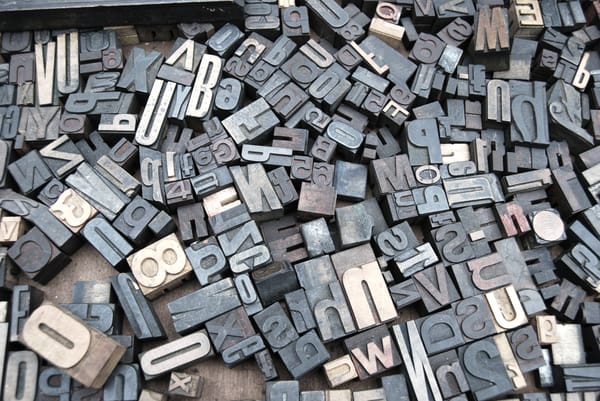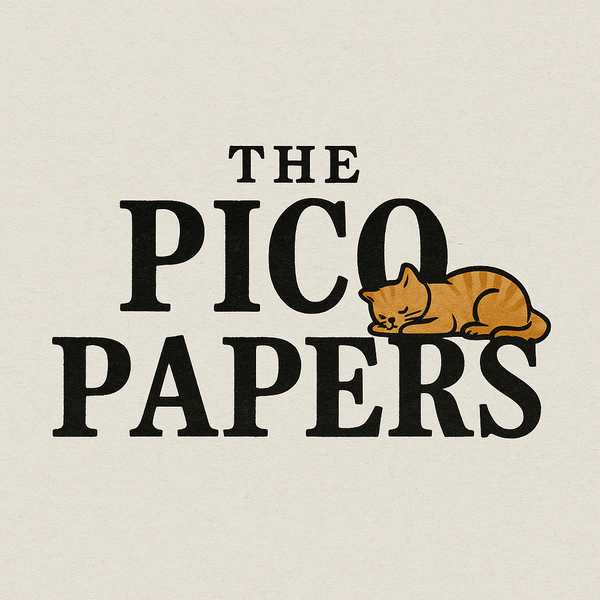Who the Law Forgets: Auschwitz, America and the Illusion of Justice

Editor’s Note
I usually keep to myself—window watcher, nap enthusiast, soft observer of a complex world. But sometimes, my human sees something I can’t ignore.
This one carries weight. So, I let her write freely.
No edits. No interruptions. Just truth.
It’s long, and it’s hard. But some truths need the room.
Pico
I didn’t know what to expect as I approached the infamous gate at Auschwitz—the one bearing the words Arbeit macht frei (Work sets you free). I had read about it, seen the photos, even taught lessons that referenced it. But nothing prepares you for the moment you walk under the phrase in real life, beneath the cold weight of its lie. My eyes caught on something I hadn’t known: the letter “B” in “Arbeit” is upside down. A quiet act of defiance. A prisoner’s hand had forged resistance into iron, and somehow, it endured.
The power of that gesture hit me harder than I expected. A letter, subtle enough to be overlooked, still held the memory of dissent. A replica, where rebellion had survived, where so much and so many had been annihilated.
As I crossed the threshold into the barracks—or Blocks—the ground beneath me felt uneven, sunken in certain places, worn down by footsteps that hadn’t walked freely. My feet kept slipping into the indentations, the impressions left by thousands before me. Even when I tried to step around them, to resist reenacting the same path, my body was drawn to those hollowed-out spaces. Repetition had made grooves, and the grooves guided me.
Dust rose and settled into my shoes. But it didn’t feel like dust. It felt like people. I felt them—traces of them—in the air, in the walls, in the floors. I thought briefly about taking off my shoes. It felt wrong to wear them, to step where others had suffered barefoot, starved, broken, or waiting to die. Every sense of mine told me I was walking inside grief.
We passed Block 10, where so-called doctors had performed experiments on hundreds of women. And then Block 11—the punishment block. There in the basement, the first mass exterminations were tested. I couldn’t breathe. There were black rooms with no windows, standing cells barely large enough for bodies. I walked through silence, but the air screamed.
Still, what haunted me the most wasn’t the suffering. It was the order. To the right, as you enter the building, there’s an office—tidy, bureaucratic. A plaque reads: “The orderly SS-officer (blockführer) who was on duty in this room often executed the sentences of Gestapo summary court.” A court without justice. Without rights. Without a judge. Death sentences were decided in minutes. Most condemned to die at the Death Wall.
What happens when there is the appearance of justice, but no justice at all?
Someone I barely knew was crying—not just softly—her whole body trembled with it. Her eyes were red; her face streaked with tears. I didn’t know her well enough to reach for her, but I felt her sorrow pressing against my own. Her visual pain made the experience even heavier, as if witnessing wasn’t already unbearable. Grief, in that moment, became communal. It moved through us.
Each time our guide used the word “deportation,” I felt physically ill. The term was so familiar, neutral, almost bureaucratic. I’ve used it myself, in legal writing, in policy briefs. But here, in this place, deportation meant something else entirely. It meant disappearance. It meant death. And suddenly, I couldn’t stop thinking:
What does deportation mean here? And what does it mean now?
The Bureaucratic Mask of Violence
The word deportation originates from the Latin word dēportātiōnem, meaning to carry away, convey off, or to banish. In modern policy, it implies due process, administrative procedure, and legality. But at Auschwitz, deportation meant something else entirely—it meant cattle cars, separation, disappearance, and death. The dissonance between word and reality forces a deeper question:
How often does language mask violence rather than reveal it?
Legal language and bureaucratic terminology, in particular, carry a false promise of neutrality. Terms like processing, removal, detention, or inadmissibility are designed to sound efficient and objective. They distance the speaker—and the public—from the lived reality of those affected. But as I walked through Auschwitz, I couldn’t ignore how eerily familiar the structure of violence sounded. Not just in what was done, but in how it was justified.
Nazism didn’t operate outside the law; it rewrote the law. It codified exclusion, hierarchy, and death with chilling precision. Deportation orders were signed. Camps were administered. Even extermination was structured around forms, categories, and quotas. Language, in this context, wasn’t just a medium of power—it was a weapon of it.
Euphemisms made it easier. Resettlement sounded humane. The Final Solution sounded like closure. These phrases shielded perpetrators from moral reckoning and dulled public resistance. Words, Miłosz warned, could become collaborators. In The Captive Mind, he wrote, “Men will clutch at illusions when they have nothing else to hold on to.” Words shape reality, and under a totalitarian rule, language becomes a refuge and a weapon. The illusion of legality provided structure while it erased justice.
Today, those same linguistic patterns persist in policy language. Migrants are reduced to “illegal aliens,” detained families are “processed,” and forced removal is cloaked in the arid term “deportation.” There is a perception that these terms carry the force of law—but legality is not a substitute for morality.
One of the most unsettling truths about the Holocaust is that it was not carried out in the absence of law—it was carried out through law. The Nazi regime meticulously codified its genocidal goals, transforming ideology into statute, and bureaucracy into enforcement.
In 1935, the Nuremberg Race Laws were enacted to institutionalize racial hierarchy in Germany formally. The Law for the Protection of German Blood and German Honor prohibited marriages between Jews and so-called Aryans. At the same time, the Reich Citizenship Law stripped Jews of citizenship, reducing them to “subjects of the state.” These laws defined Jews by ancestry—not religion or belief—but bloodline, regulating identity through categories, charts, and racial math. While initially focused on Jews, the Nuremberg Laws applied to Roma or Gypsies, Black people, and their descendants.
This approach served to systemically alienate Jewish and others perceived as inferior races from their neighbors and communities. More laws and restrictions followed. In 1938, the Law on the Alteration of Family and Personal Names set new name requirements for Jews in Germany, and the Decree on Passports of Jews. In 1941, Nazi Germany implemented the Police Regulation on the Marking of Jews, requiring that all Jews over six years old be marked by a yellow six-pointed star with the word “Jude” in the middle.
Once codified, persecution became policy, and policy became enforceable. Deportations were the law. Concentration camps were built and staffed in compliance with state procedures. At every level, the law was present—not as a safeguard but as an instrument.
This forces a confrontation with a complicated reality: law is not inherently just. Law reflects power. When power is corrupted, law becomes its echo. In Auschwitz, I saw that echoed structure in every building, every ledger, every sign. It was not chaos—it was order, executed without conscience.
Dehumanization doesn’t begin with violence—it starts with words. The Nuremberg Race Laws were not introduced in a vacuum. They emerged after years of antisemitic propaganda that casts Jews as threats to national identity, purity, and security. The law was just the next strategic step to make exclusion look orderly, rational, and inevitable.
This pattern—where rhetoric softens the ground of repression—is not confined to history books. In the United States today, we are witnessing an alarming resurgence of language that echoes these same tactics. Where migrants are described as “poisoning the blood of our country,” cities are framed as “infected,” and human beings are labeled as “animals,” “aliens,” or “invaders.”
I do not write this for comparison. Human suffering should never be compared. I write as a warning. When hate speech is spoken from podiums and codified in policy, when categories become tools of separation, and when cruelty is justified as legality, we should not wait until it is too late. We should not wait for the trains to start running. Arrest by masked men and taken to unidentified locations should be enough to ring the alarm.
As a researcher, I am trained to trust documents, such as statutes, orders, and evidence. But standing inside Block 11, I no longer feel that any document could be trusted. What is the law, after all, if it can be used to justify horror? And what does it mean for someone like me—who has built a life, a career, and a sense of belonging in a country where legality is often treated as the final word?
I wasn’t born in the United States. I became an American. By choice. By hard work. By paperwork. But above all, by faith in a system that claimed to reward fairness and due process. But that faith is starting to fracture. I’ve watched citizenship become conditional again, dignity politicized, borders militarized, and belonging reduced to a box and technicality. I’ve seen words like deportation used so casually—even by me—without fully reckoning with what they mean in the wrong hands.
Auschwitz didn’t just confront me with the past. It made me question my present—and whether any legal status can truly protect you in a society sliding towards cruelty.
Citizenship and the Fragile Promise of Protection
In my early twenties, I left Venezuela—the country of my birth—to move to the United States. My father was an American, which created a path for me. But nothing about that process felt certain. Hiding my fear of Chavez's rise to power, I remember standing in line at the U.S. embassy, papers in hand—so many papers. Fear was tightening my chest. When the visa stamp finally hit my passport, it felt as if it was more than just ink. It felt like a door cracking open, during a time when all the windows of a once beautiful country were being shut and overtaken by fear and violence of the authoritarian regime.
I felt hope.
I wasn’t rushing towards some glossy version of the American dream. I was young, emotionally broken, but with one clear goal: to provide a safe home to my son. So, I moved. I did it all. I cleaned houses. I washed boats. I worked late shifts at a bar. I learned the language one word at a time. When the time came, I studied American history—not to pass a test, but because I believed the oath I would soon take required more than recitation. It required responsibility.
When I swore allegiance, I did so fully aware of the nation’s flaws—its long history of exclusion, injustice, and contradiction. But I also believed in the idea of the United States. Not as a perfect union, but as an experiment—one that could be improved through participation. I thought I had a duty to contribute, to ask hard questions, to help shape something even better.
And yet, standing in the middle of the evidence of the most horrific crimes against humanity—surrounded by debris of one of the chambers that systemically break the soul, take the air, and turn bodies into ash—I felt something inside me fracture. The debris wasn’t only physical. It was emotional, it was spiritual, and legal. It was the wreckage of what law once authorized. The wreckage of what legality once justified.
If law can be bent to erase justice, and citizenship can be stripped when convenient, then what does my passport really protect? Who am I if the system I became part of turns on people like me?
Cruelty by Design: Policies that Punish
I carried that fracture with me. In the days after Auschwitz, I found myself listening differently—to news reports, policy memos, political speeches. What I had once heard as “law and order,” I now heard as a warning. What I had once treated as distant or objective policy language, I now recognize as narrative control. And I began to ask myself: Are we already seeing the early architecture of exclusion retake shape?
In 2018, the U.S. government implemented the “zero-tolerance” policy, which mandated the criminal prosecution of all undocumented border crossings. Prior to these illegal crossings, they were treated as civil offenses, meaning they resulted in administrative actions, such as deportation or fines, rather than criminal prosecution. As a result, thousands of children were forcibly separated from their parents—many times without records, making reunification impossible. In internal administration memos, this was described as a deterrent strategy. The language was calculated; family separation became “prosecution initiative,” children were labeled “UACs” (Unaccompanied Alien Children), and the trauma was managed through bureaucratic abstraction.
Today, some of those children are still missing.
Further south, a proposed detention center has become a reality. Located in the Everglades, west of Miami, Florida—quickly dubbed “Alligator Alcatraz”—was designed to warehouse migrants in conditions likened to military encampments. There is an uncanny resemblance to those encampments and internment camps to detain Japanese Americans and others the government perceived as a threat following the Pearl Harbor Attacks. Not too long ago, in 1988, the U.S. government recognized that “race prejudice, war hysteria, and failure of political leadership” motivated the unnecessary mass incarceration without any military or security justification. Still, it is impossible to question if we are committing the same mistake, fueled by manufactured national emergencies, we are building new cages for people perceived as a threat—again.
Across the country, detention quotas have fueled the expansion of private prisons, and migrants are being held not based on risk or criminal record, but to meet contractual obligations. As of 2025, the U.S. has the largest immigration detention infrastructure in the world and currently functions under a congressional-mandated immigration detention quota.
The country that once welcomed the world’s tired and poor yearning to be free is now guided by a hardened language. Migrants became “animals,” their presence framed as an “invasion,” their very existence labeled as a threat to the nation’s “blood.” These are not metaphors. They are echoes—echoes of what leadership without a moral compass sounds like.
At the borders, militarization has deepened. Surveillance balloons, drones, and internal checkpoints redefined the landscape not only of those trying to enter, but also for those living in fear within. Immigration enforcement no longer stops at the border; it seeps into hospitals, courthouses, schools, and homes.
And through it all, citizenship itself has begun to shift—from protection to a weapon. Birthright citizenship, once perceived as an ironclad constitutional protection under the Fourteenth Amendment, is being litigated. Talk of denaturalization, ideological vetting, and “citizenship-stripping” of those deemed unworthy reanimates the idea that belonging can be conditional. That our legal protections can be undone with the stroke of a pen by a man convicted of 34 felonies. If there were equal treatment and the law was about justice, the one signing the executive orders should be stripped of his citizenship.
The structure is familiar. Violence softened by language. Cruelty made palatable through policy. Public acceptance was achieved not in spite of the suffering—but because it’s been framed as necessary.
Rejecting Neutrality: The Ethics of Witnessing
During my time in Poland, reading Polish, Czech, and Ukrainian literature, I noticed a recurring phrase to bear witness. That simple call appeared again and again—in poetry, memoir, political reflection. It made me pause. What does it truly mean to bear witness?
At first, I believed it meant seeing and remembering. Naming what happened so it would never happen again. But immersed in others’ prose, exile, and suffering, I began to realize that witnessing without action is not enough. Even in the legal context, a witness is an active party. They testify—for the prosecution or the defense. Witnesses are not neutral.
To bear witness, we must renounce apathy. We must do more than restate or remember. We must recognize. And we must act.
“Never Again” has long served as a global refrain—a vow spoken with reverence at Holocaust memorials and in human rights conventions. But too often, it lives in the past tense, a historical promise divorced from present responsibilities. What does “Never Again” mean when children are in cages, when families are separated as deterrents, when legal frameworks are used to strip people of belonging? What does it mean when we normalize suffering through euphemism, and when cruelty wears the uniform of order and law?
We often expect evil to look dramatic—to come in the form of villains, spectacle, or violence. But as Hannah Arendt observed in Eichmann in Jerusalem, the most terrifying aspect of evil is often its ordinariness. It's banality. It shows up in paperwork, quiet compliance, and procedural efficiency. The machinery of injustice runs not only on hatred but on habit—on people doing their jobs without stopping to ask whether what they are doing is right.
That realization impacts me the most. Because I have been one of those people. I have followed rules, filled forms, and translated policy into practice. And I know it is easy to believe that staying in your lane is enough. But Auschwitz teaches otherwise. When systems become instruments of cruelty, neutrality becomes complicit.
This is not a call to equate atrocities. It is a call to recognize the patterns. Poland’s past is marked by unspeakable pain, yet also by lessons—about how ordinary people learn to look away, about how language can gradually replace humanity, and about how legality can become a trap. The exact mechanisms that permitted genocide—dehumanization, state control, silence, procedural compliance—do not belong to history books alone. They exist wherever cruelty is rationalized by authority, and wherever fear is used to justify exclusion.
In The Captive Mind, Miłosz describes how a man in Warsaw asked him, “Are Americans really stupid?” The chapter that follows makes even the most American reader hesitate. Have Americans become so comfortable that we refuse to acknowledge the shared reality of our differences? Has the marketing of the American dream made us all complicit? Is this history whispering into the ears of individualists that we should care about others? Have our comfort and our culture of immediate satisfaction made us lazy thinkers—allowing those in power to distort the idea of the United States?
Is this my fault?
So many questions without answers. Still, I no longer believe it is my job to stay neutral. My role is not simply to observe or report with academic precision. My job is to question. To ask hard things before it’s too late. To seek answers—especially for those questions that resist easy resolution.
A global pattern is at work—one of silence, exceptionalism, and paralysis. We see the suffering in Gaza and Ukraine. We watch the helpless as regimes suppress dissent, rewrite the law, weaponize citizenship, and erase belonging. What keeps us from acting is not ignorance. It is the comfort of distance. The fallacy is that if the suffering is far away, it is not our responsibility.
However, the lesson of Auschwitz is that moral distance is an illusion. We are all participants in the systems we permit, the words we use, the borders we enforce, and the laws we write.
The question is not whether history will repeat itself exactly—it won’t. The question is whether we will recognize the signs this time. Whether we will speak up while our voices still matter. Whether we will accept the quiet convenience of neutrality or bear the weight of witnessing with intention.
To bear witness is not just to see—it is to respond.
To remember is not just to reflect—it is to resist.
And in a world increasingly willing to forget, that resistance is everything.




